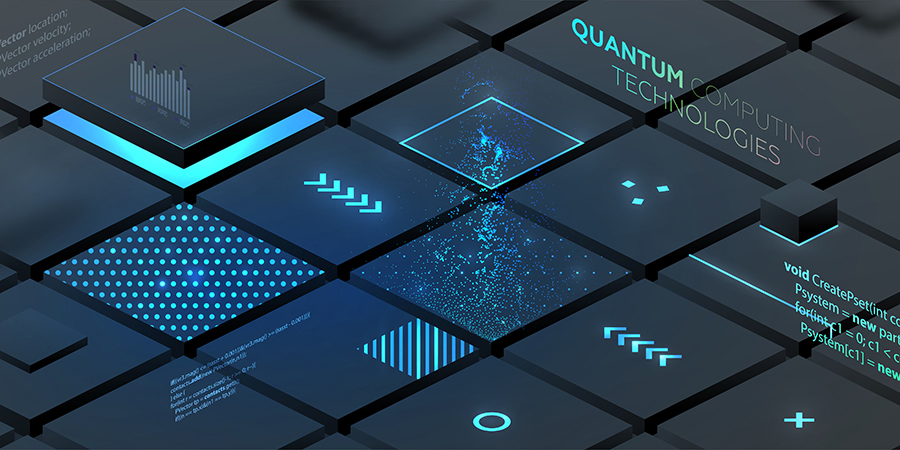Abu Dhabi is currently building its own quantum computer — the first innovation of its kind in the UAE.
Quantum computing’s potential relies on network capacity, performance, reliability, and security. Most importantly, its ability to comprehend and simultaneously consider an infinite range of scenarios makes it different from traditional computing. In principle, quantum computers are able to perform complex calculations at 100 million times the speed of current computers.
Over the next few years, anticipation is strong towards this technology’s shift from high-tech labs to mainstream commercial use. Taking this into account, quantum computing represents the next major breakthrough in modern ICT, disrupting the internet, smartphones, and cloud computing altogether.
Nearly a century after the foundations of quantum mechanics were laid down, ambitions for making more strategic use of this technology are being explored. Without a doubt, the second quantum revolution is upon us, and it is not only about quantum computing. Rather, the novel computation technology will be one component of a revolutionary movement, wrapped in a new generation of sensing, communication, and simulation.
As quantum technology continues to mature and be understood (e.g entanglement and superposition), the race to the next stage is still a long way to go. Scaling the infrastructure and real-time use cases are yet to be established for the long run.
In a nutshell
2019 marks the year when Google was internationally acclaimed for quantum supremacy when its prototype quantum computer completed a calculation in minutes that would have taken a supercomputer 10,000 years to do. Following this in 2020, China’s leading quantum research group declared achieving quantum supremacy as well after a system called Jiuzhang produced results in minutes. Based on their calculation, it will take more than 2 billion years of effort from the world’s third-most-powerful supercomputer to accomplish this feat.
These two quantum-centric systems allowed the world to see the potential of quantum in different ways — with Google using supercold, superconducting metal, while the team at University of Science and Technology of China manipulated particles of light or photons.
Yet, quantum computing remains complex and these experiments still need years of further development before an actual quantum computer is ready to do useful work. Despite that, this embryonic industry opens a new paradigm of computing that uses the very fabric of reality to solve problems that could not be solved before.
Based on quantum mechanics, quantum computing is based on qubits which can represent much more than ones and zeros. In the quantum world, data from quantum devices like a quantum computer or a quantum processor can be encoded in the state of qubits. Hence, the birth of the so-called quantum internet. This network will let quantum devices exchange information under much cryptic capabilities that are impossible to carry out in today's web applications.
As massive data generation exists today, sensitive data is typically encrypted and then sent across fiber-optic cables and other channels together with the digital keys needed to decode the information. The data and the keys are sent as classical bits which are vulnerable as smart hackers can read and copy bits in transit without leaving a trace.
Quantum communication resolves this by taking advantage of the laws of quantum physics to protect data. These laws allow qubits—typically photons for data transmission along optical cables—to take on a state of superposition, which means forming multiple combinations of 1 and 0 simultaneously.
From a cybersecurity perspective, if a hacker tries to observe the qubits in motion, their quantum state collapse to either 1 or 0. In this way, a hacker can’t tamper with the qubits without leaving behind a noticeable trail. Some companies have taken advantage of this property to create ultra-secure networks for transmitting highly- sensitive data based on a process called quantum key distribution, or QKD.
Security with quantum key distribution
Quantum communication specifically addresses secure cryptography. To illustrate, a broad range of data and information are being transmitted on a daily basis online — personal messages, card details, browser history, etc. Through a key exchange between your browser and visited, the encryption of data transmission takes place. Theoretically, somebody could eavesdrop and compromise this process. Therefore, quantum communication provides a new fundamentally unbreakable option for key exchange — QKD.
To explain how quantum key distribution works, we can take a look at one of the properties of qubit: coherence. As mentioned above, the act of looking at a qubit destroys its coherence — its quantum state. By fundamental properties of physics, the whole system will behave differently going forward and a clear mark will be left behind. So, encoding keys in quantum states can ideally make cybersecurity loophole tracking easier. In effect, you can see a broken pattern which can influence an automated rule. Opening a secure channel can then be set only if a pattern is unbroken and the key is uncompromised.
If it’s been compromised, exchanging to another key is a good idea. As a result, QKD enables the development of ultimately secure and physically impenetrable encryption mechanisms. With this in mind, integration of QKD in telecom networks involves long distances in optical networks that can be achieved only via a chain of trusted nodes.
Based on an EPJ Quantum Technology research, most of the QKD testbeds have been designed as separate networks due to the difficulty of transmitting and detecting quantum signals. This is done to avoid as much as possible the losses and the interaction with classical signals. As implied, to achieve real integration, a design in which a logical infrastructure combines the management and services of the QKD networks within existing telecom networks should be considered.
Quantum integration in telecom: SDN
When considering the integration of quantum technologies in telecom networks, the same research source gave a good explanation on how quantum capabilities can serve as an add-on to an existing telecom network, particularly towards the data forwarding plane in the software-defined networking (SDN) technology.
SDN was conceived as a means to add flexibility to the network where the core concept relies on resiliency so it will not be possible to break the whole network by just taking down a single node. The control and data planes in the SDN approach are separated by design and mixed in each node, which in certain aspects took decisions on its own.
Moreover, network devices (aka switches) and the network are supervised by a control and management plane which is embodied in a SDN controller — a software running on standard computing equipment responsible for the devices/applications communication using standard protocols and modelling languages. The resulting architecture greatly simplifies the overall network management. This model has also facilitated other paradigms like the network function virtualization (NFV) which that pushes further the shift to a fully software-based network.
This flexibility makes the integration of quantum devices in a telecom operator network easier as well. How? By having a QKD device’s information model written in a standard language that can be understood by the SDN controller. Accordingly, the QKD system becomes a type of network device managed based on the encoded rules. This paradigm allows working with either a quantum-only network that connects through a network orchestrator or a fully integrated network sharing a large part of the physical infrastructure. The scheme also allows for an evolutionary upgrade where installing QKD systems is done only when needed, in contrast with the old schemes that required specific node by node modifications.
In support to this, the SDN-QKD scheme has been demonstrated in another study published by IEEE which tackled how SDN network architectures can incorporate new quantum-safe algorithms and use the existing security protocols. Thus, gaps within today's network security are bridged. This can be done without zero-day migrations and expensive upfront costs.











